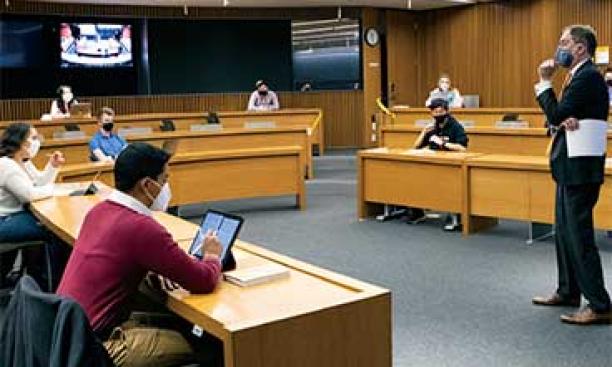
My freshman seminar, “Free Speech in Law, Ethics, and Politics,” met in person on Thursday, February 4. It felt great to be back in a classroom, together with Princeton students.
The first session of the class had taken place two days earlier on Zoom. I had expected that meeting would be in person, but a blizzard shut the University for two days. As a result, I had to defer the first in-person session, something I had been anticipating for weeks.
I was delighted, first of all, to be teaching again. In a normal year, my travel and events schedule make it difficult for me to be in the classroom. The pandemic has grounded me, however, so my calendar can accommodate the class.
I also wanted the chance to do something with our students and to experience our campus protocols for in-person teaching. I am confident that we know how to teach safely: we carefully monitored other colleges and universities that followed rigorous safety protocols in the fall, and instances of classroom transmission were extremely rare.
A safe college classroom during the COVID-19 pandemic is, however, a strange-looking place. We all wear masks, of course. I spent a few days testing out options, making sure that I had a mask that allowed me to speak comfortably and did not fog up my glasses.
We also distance from one another. Under New Jersey state regulations, every student must be six feet away from every other student and six feet away from me at all times. We therefore cannot gather around a cozy seminar table. Instead, the 12 students are spaced around a horseshoe-shaped lecture hall with a normal seating capacity of 60.
The six-foot restriction places a serious constraint on room availability on campus. It means that big classes cannot meet at all, and even small ones, like my own, require large rooms and significant advance planning. Our facilities and health staffs have marked permissible seats for the students to ensure appropriate separation among them.
We have tech support with us in the classroom to facilitate hybrid teaching if any students needed to participate remotely. I am lucky: all of the students in my course came to campus this semester, so, as long as we’re all healthy, we can all be in the room together.
Even so, we have to be ready with remote options in case any of us are showing symptoms, or test positive for COVID-19, or have to quarantine because we’ve been exposed to someone who tested positive. If I wake up with a cough, I must teach remotely. If students do, they must attend via Zoom. And we have to be ready for that possibility every day the class is due to meet.
And, of course, we all follow careful protocols outside of class to stay healthy: masks, distancing, and strict limits on gatherings, travel, and activities. For example, the maximum number of people for an approved gathering on campus is five indoors or ten outdoors. There is an exception for classes, making my fifteen-person gathering (12 students, myself, my assistant, and our tech support) relatively gigantic.
The undergraduate students submit saliva tests twice a week. I submit a test once a week, along with all other faculty and staff who come to campus regularly.
Given these restrictions, it is no surprise that most Princeton classes are remote. Many have to be: our classrooms could not accommodate the distancing requirements. And many of my colleagues judge the challenges of genuine hybrid teaching, masked-up in person and on Zoom at the same time, to be more frustrating than they are worth.
For me, though (admitting that it is early innings for now), the benefits of in-person teaching are substantial. I can make eye contact with the students, and they can make eye contact with one another. They are not distracted by whatever else is happening in or near their rooms, or on their computer screens.
When I stumble into the lectern while talking—a not uncommon occurrence in my classrooms—we all laugh together, something that is not so easy to do on Zoom (though, as I told the class, at least I don’t run into any virtual lecterns).
I also want to develop experience with currently available in-person teaching options as we prepare for a more normal fall. Between vaccines and new viral mutations, we continue to confront an uncertain future. I have, however, asked our team to plan on the assumption that we will be fully residential in the fall, with a resumption of most activities.
My expectation is that the fall will be far closer to normal than anything we have seen in the past twelve months. My guess, though, is that we will still be dealing with lingering effects of the pandemic. We need to be ready to address them imaginatively, finding ways to restore as much of the Princeton experience as we prudently can.
We’ll see how things go in my seminar in the weeks ahead. We are not out of this pandemic by any means, and no doubt there are unanticipated challenges ahead. But for now I can say this: I am thrilled to have the majority of our undergraduates back on the campus and even happier to be in the classroom with them.
